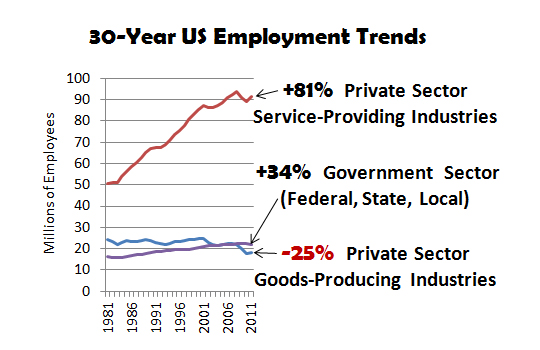To see where one is going, it is often useful to look back to where one has been. Today, the common perception is that the private sector workforce has been decimated and the federal government workforce has exploded in its place. These perceptions are only partly true. A deeper understanding is important for healthy economic and policy decisions. This blog looks back 30 years. The next blog will deal with recent US employment trends so far this decade, the “10s.
From a Jobenomics perspective the three most important employment sectors include: private sector service-providing industries, private sector goods-producing industries, and the government sector (federal, state and local). The 30-year employment trends (shown above) were calculated by the Bureau of Labor Statistics.
Private sector service- providing industries have grown significantly at 81% over the last three decades in terms of raw numbers. Even if these numbers were adjusted relative to 36% US population growth (230 million in 1981 to 312 million today), the growth in this sector is still significant. Private sector service-providing industries include:
-
Trade, transportation, and utilities that employ 25.1 million Americans and have experienced a growth rate of +36%.
-
Professional and business services employ 20.2 million with a growth rate of +162%.
-
Leisure and hospitality employ 13.3 million with a growth rate of +96%.
-
Financial activities employ 7.6 million Americans with a growth rate of +49%.
-
Information (telecommunications not including internet, publishing, motion picture, broadcasting, data processing/hosting) industries employ 2.7 million with a growth rate of +13%.
-
Other services (repair and maintenance, personal and laundry services, membership associations and organizations) employ 5.5 million with a growth rate of +93%.
The central focus of the Jobenomics movement is on the private service-providing sector since it historically has been the most robust and is projected to the most robust in the future. Additionally, this sector, combined with the advent of “big data age” and new 21st Century networking solutions, will be the one most advantageous to small, emerging and self-employed business creation. Small business has been responsible for virtually all of the new US jobs this decade (see previous blog entry entitled, Small and Self-Employed Businesses Produced Almost 100% of Net New Jobs This Decade). If America wants to maximize jobs creation, it should focus on small, IT-empowered, services businesses that have enjoyed double and triple digit growth rates.
Private sector goods-producing industries have deteriorated by 25% over the last three decades. If adjusted for US population growth deterioration of this sector exceeds 50%. Private sector goods-producing industries include:
- Manufacturing (durable goods) employs 11.8 million with a negative growth rate of -37%.
- Construction employs 5.5 million with a growth rate of +36%. Note: construction has taken a massive hit since the Great Recession in 2008 but is still up from 1981.
- Nondurable goods (food manufacturing, textiles, apparel, paper/plastic/rubber products, etc.) employ 4.4 million with a negative growth rate of -37%.
- Mining/logging employ 0.7 million with a negative growth rate of -35%.
While Jobenomics acknowledges the importance of the goods-producing sector, with the exception of foreign owned businesses coming to the USA, this sector is unlikely to contribute more than 10% towards the Jobenomics goal of 20 million new private sector jobs by year 2020 (20 by 20). In this author’s opinion the manufacturing and construction industries are likely to continue to decline despite all the Washington rhetoric. US manufacturing suffers from high government regulation as well as high labor costs relative to foreign goods-producing industries. Washington’s promises of a less austere regulatory environment and fair trade agreements will take years, if ever, to enact and implement. US construction is highly dependent on the housing industry that will remain depressed for years to the over abundance of foreclosures and short sales. Washington efforts, like the Home Affordable Modification Program (HAMP), have failed to reduce the plight of underwater homeowners and foreclosures.
Consequently, the Jobenomics near-term emphasis in the goods-producing sector is on bringing manufacturing back to America by incentivizing foreign-owned businesses to manufacture a greater percentage of their products in the USA. In the 1980s, the Japanese were incentivized to start numerous US automobile plants that now employ 150,000 US workers. The Jobenomics Center for Industrial Development initiative is designed to attract foreign businesses and foreign investors via the US Customs and Immigration Service EB-5 foreign investor program. The Jobenomics goal is to create 3 million new US jobs via foreign-owned corporations. If foreign corporations want access to America’s $14 trillion annual GDP, then it is reasonable to” incentivize” them to build in America.
The government sector (federal, state and local) has grown by 34% over the last three decades. When adjusted for the increase in population, government is employing approximately the same percentage of people per population today as yesteryear.
- Contrary to popular perception, the US federal government has lost -5% over three decades. In 1981 the feds employed 2.96 million, whereas in 2011 it employed 2.82 million. However, these numbers do not include the explosive growth of government contractors which employ approximately 10 million people who represent a significant portion of the outsourced government jobs to the private sector.
- State government and local governments employ 5.1 million and 14.2 million and have grown by 40% and 46% respectively over the last three decades. However, due to the Great Recession, and its concomitant decrease in tax revenues, state and municipal governments are laying off significant number of personnel during the last several years. If the US economy reenters recession, a double-dip, it is not inconceivable that state and municipal governments will have to lay-off 2 to 3 million more employees to balance budget shortfalls.
The Jobenomics Plan for America calls for zero growth in government. This zero growth goal should not be hard to achieve since all levels of government will continue to shed jobs as outlays continue to outpace revenues for the foreseeable future.

